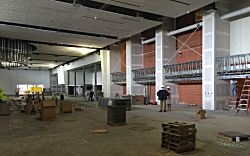A new era at The Red Mile
July 3, 2015,by Tom LaMarra, USTA Web Newsroom Senior Correspondent
Lexington, KY — There will be many changes for patrons and horsemen when The Red Mile begins its 2015 harness meet July 26 in Lexington, Ky.
As part of a partnership with Keeneland, all Thoroughbred simulcasts will move to The Red Mile effective July 15. So the harness track will become a multi-breed operation with full-card simulcasts seven days a week from noon to midnight.

Construction continues on the historical race wagering facility at The Red Mile.
The second floor of the facility — the level that leads out to the track apron — has been renovated and expanded to accommodate the additional business. It’s now about 35,000-square-feet with roughly 200 flat-screen televisions and two bar/concession areas.
The 75,000-square-foot first floor that will house 906 historical racing machines is set to go online in early October. It’s a combination of additional space and the first floor that once housed the lobby, racing office, and general offices at The Red Mile.
The old grandstand seats and owners’ boxes remain, with some roof repairs and new paint.
Red Mile president Joe Costa and Keeneland president Bill Thomason said July 2 they hope the new facility provides energy for Lexington racing fans and bettors. The joint project, which will cost tens of millions of dollars, will be part of Lexington’s growing downtown sector.
“This is an opportunity to create a place to offer patrons the full gamut of national racing product,” Costa said. “We feel that together we are stronger than functioning separately.”
The Red Mile in the late 1990s sold its Thoroughbred simulcast rights to Keeneland, and since then has offered only Standardbred and Quarter Horse simulcasts. Much of its pari-mutuel business now comes from its advance deposit wagering operation, which can take only harness and Quarter Horse bets.
Originally the two tracks planned to partner and build a facility for historical race wagering at The Red Mile. Then each track decided to build their own. Last year, however, they changed their minds and struck a deal.
“Once we started talking together we realized how complimentary our objectives are,” Thomason said. “We want to make sure we keep people coming to the racetrack, and we now have the ability to do it in a way so it’s complementary to our two industries.”

Tom LaMarra photos
Red Mile president Joe Costa (left) and Keeneland president Bill Thomason (right) in the new simulcast facility at The Red Mile.
Keeneland will continue to offer full-card simulcasts during live race meets, sales, and major racing days such as the Triple Crown and Breeders’ Cup. It will have a satellite facility in The Red Mile, which also will be open on those days.
The facility will be designed to allow those only interested in live racing and simulcasts access without having to enter the historical race wagering facility. The “horsemen’s entrance,” as it’s called, will provide direct access to the track apron, simulcast area, and clubhouse, which will be renovated for 2016 as part of a second phase of the project.
Construction and the need for parking facilitated removal of some barns, the paddock under the grandstand, and the racing office. Thus, the racing office will move to a modular facility in the barn area, and the long-abandoned paddock on the far turn has been refurbished.
Costa said about 70 stalls ended up being removed. “But we scoured the facility to basically add back 40 stalls that were substandard and not used in the past. We renovated them, so the net loss of stalls is only about 30.”
Costa said there is room for temporary structures to house more stalls, and he indicated demand for stalls at The Red Mile would be a good thing for the racing product in the future.
“I think we’ll have enough room,” he said. “Actually, we hope to have a problem with not having enough stalls back there.”
Under a new contract with the Kentucky Harness Horsemen’s Association, purses this year for the “Kentucky meet” that leads into the Grand Circuit meet will be 40-50 percent higher than last year. The Open Pace went for a $5,000 purse last year, so it could be about $10,000 this year.
The horsemen’s group, in an effort to help get the new facility started, agreed to a guaranteed amount for purses from 2015-17. The number of racing days will go to three nights a week — Thursday, Saturday, and Sunday — from two in 2014, and it’s expected if historical race wagering proves successful, more racing dates will be added in future years.
Costa said the additional purse money the next few years will assist horsemen in gradually improving their stock. “We have to transition people through this process,” he said.
Thus far at two tracks in Kentucky, historical race wagering machines have generated about $1 billion in play from September 2011 through May 2015. Almost $10 million in purse money has been generated.
Officials wouldn’t discuss historical racing revenue projections for the Lexington facility, though it’s believed it will be at least as successful as the one at Kentucky Downs on the Tennessee border.
Last year the Kentucky Supreme Court ruled the Kentucky Horse Racing Commission had the right to promulgate rules for historical race wagering, which involves use of old races to trigger different games on screens that resemble video lottery terminals. A circuit court is still dealing with a suit from the Family Foundation of Kentucky, which maintains the machines aren’t pari-mutuel in nature.
The racetracks in Kentucky have said the machines are pari-mutuel because they are linked and the bets are common-pooled under various formulas.
